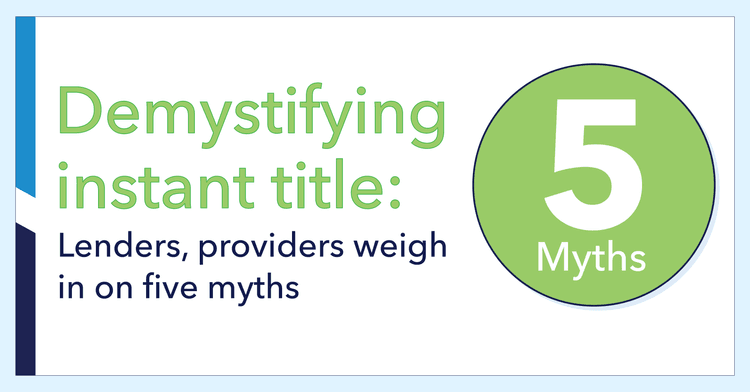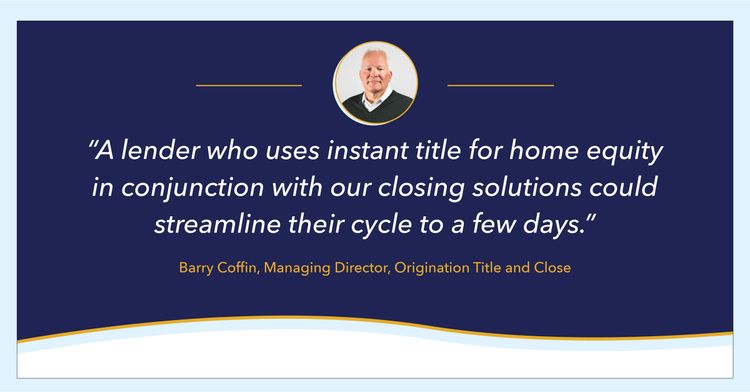Data quality and collaboration are key to implementing this emerging technology to its fullest.
Getting borrowers to the closing table faster and delivering an exceptional customer experience are ongoing priorities for mortgage lenders. Many have found instant title to be an essential tool for not only making the mortgage process faster and more convenient for borrowers, but also differentiating their brand in the highly competitive market. Yet myths around instant title remain. In this article, three industry experts explore these myths and offer both lender and title provider perspectives into making the most of this transformative technology. Insights follow from these experts: Jim Gladden, SVP, Client Strategy; Michael Moore, SVP, Pennymac; and Barry Coffin, Managing Director, Origination Title and Close.
Myth 1: The title process hasn’t changed in decades.
Reality: Artificial intelligence, machine learning and continuous improvement of data aggregation processes have fueled revolutionary and evolutionary changes.
“We have seen many changes over the years from a title perspective — from the old days of sending abstractors into the land records office to search records, manuals and books, to the digitizing of those land records and our ability today to take all of that data and automate the instant title process,” says Barry Coffin. “ServiceLink, a company that’s been around for decades, started looking at automated title during the previous refi boom, when HARP [Home Affordable Refinance Program] was put into place in 2008-2009. Today we offer EXOS® Title, which uses AI, machine learning and cloud-based automation engines to provide instant title in a matter of minutes.”
From a quality perspective, ServiceLink’s instant title offering is no different from standard title, Coffin adds. “You’re getting the same coverage — all of the information needed to meet our underwriters’ compliance guidelines as well as those of the secondary market.”
Lenders and consumers have come to expect quick decisioning, ServiceLink’s Jim Gladden points out. “Over the past couple of years, we’ve looked at the title process very much like the government-sponsored enterprises (GSEs) do with their automated underwriting systems. Originators can grab title information at the point of sale and provide a complexity decision that satisfies the borrower’s desire for speed and more transparency into the process. Instant title has removed barriers to speeding up the process for both home purchases, refis and home equity lending.”
Of course, speed means very little if data quality is subpar. Title companies must have the ability to leverage their historical data, in addition to public records, as part of the data aggregation that informs their instant title decisions. ServiceLink, for example, has access to title plant repository information that has been aggregated over more than 10 years by Fidelity National Financial. As aggregation methods continue to improve, instant title will continue to evolve.
Myth 2: The settlement provider has no impact on the consumer experience
Reality: The settlement provider, and the instant title solution they deliver, can make a tremendous impact on the consumer experience.
In many cases, settlement service providers directly represent the lender’s brand as they interact with the borrower throughout the curative and closing process.
Michael Moore of PennyMac Loan Services says, “With all the automation we've developed on the lending side of the house, now the title provider has — from the very first title order and receipt of the 1003 — all the information, and they really do own the communication with that borrower with respect to how they’re vesting in that transaction. On some loans, the vendor actually has more communication with the borrower than we may have. It�’s incredibly important that title vendors take ownership of that communication throughout the transaction.”
The instant title solution itself holds the power of improving the consumer experience, too. In addition to providing borrowers with a quick commitment, the right title solution can set their expectations for the timeline and empower them through technology to engage in the process. For example, ServiceLink provides the borrower with the option of scheduling their closing immediately, from their own mobile device, clearing the way to the closing table.
Myth 3: All instant title products are the same. Reality: Instant title products vary widely. It’s important to compare.
Reality: Instant title products vary widely. It’s important to compare.
Gladden cautions that instant title products are not the same and that lenders should be strategic in the solution they choose. “Market demand has brought a lot of recent entrants into this space, so it’s key to know whether a potential partner has been through multiple market cycles that would test the rigor or the logic that's behind the decision output and the data that come through in issuing that title insurance commitment,” he advises. “You also need to know how they are aggregating and protecting data, and how available their product is across the country.”
Here are some questions to ask of potential title partners:
- How long have you been offering the instant title product?
- What history can you share?
- What is your loss or claim experience?
- What are the sources of your data?
- What level of security do you maintain around the public and nonpublic consumer data you aggregate?
- What is the scope of your coverage?
Coffin reinforces the advantages of deep experience and shares his view that the 10-plus years of data available electronically to ServiceLink through Fidelity and other sources is “second to none.” He shares, “Our automation engines can access millions of records of previously insured parcels of land. The end result is standard ALTA title commitments and final policies that meet underwriter and secondary market guidelines, and are accepted in all 50 states.”
Myth 4: It’s disruptive to take advantage of the benefits of instant title.
Reality: Collaboration between lenders and title providers facilitates the title process.
Moore shares the lending perspective: “In this competitive environment, we need to be able to reduce the number of days to close. Title vendors should be thinking about enabling the lender to close within 10 or 11 days from receipt of the application. They should do all the documentation, the closing protection letter, the tax certifications and the updated total commitment — not just the prelim — and provide all of that information in a format we can ingest into our loan origination system. This speeds up the process and helps us shrink that timeline.”
Gladden explains the chain of activities on the title provider side. “First, we provide, within milliseconds, a complexity decision that gives the lender an indication of certainty related to the speed of the curative process and then, within minutes, a commitment. We take that commitment and the data around it, as well as the data around the curative pieces of the process, and share it with the lender in a format that eliminates their need to retype. This data is available way up front in the process to help streamline, or even eliminate certain portions of, their title review to help them move through their process much faster.”
Myth 5: Instant title means that customer service is no longer important.
Reality: “High tech and high touch have to go hand-in-hand,” explains Gladden.
Given all that happens behind the scenes with instant title, some question whether customer service is still important at this stage in the mortgage process. Coffin cites data taken from the ServiceLink 2021 State of Homebuying Report: “Every spring, we survey borrowers about their mortgage experience. In 2021, 30% of them said they would like more transparency into the steps and timeline involved in the mortgage process. This confirms the critical need for customer service in every step of the process — from title and curative through closing and, in some cases, even through the funding process on the backend.”
Moore adds that reaching out to the borrower can also help reduce the mortgage timeline. “We developed automated underwriting systems 20 or 25 years ago, but they’re not the be-all and end-all. Like title companies’ automated engines, our automation does a lot of the up-front work, but so much still has to happen on the back end to complete that file properly, including bringing the customer into the process where it's necessary. This is why it is imperative for us to involve the title vendors in our lending process. If we're not partnering correctly with our title vendors throughout the entire process, we're missing something. We need to work together to be able to shrink the timeline down to where we need it to be for everybody. Then it becomes a win-win-win.”


